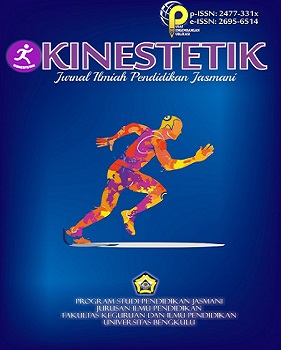Main Article Content
Abstract
This research is a research activity testing the effectiveness of table tennis digital teaching materials, which previously this product has gone through a development process (expert judgment, small-scale field tests and large-scale field tests). This study aims to obtain teaching material products that are effectively used by students in learning table tennis. The method used in this research is the experimental method. The subjects involved in this study were 30 experimental groups and 30 control groups. The subjects of this study were students who were taking table tennis courses at the Physical Health and Recreation Education Study Program, Medan State University. The data analysis technique used in this study is the feasibility percentage technique. Based on the results of data analysis, it can be described that the results of the research can be seen from the results of the pretest, the two groups have almost the same percentage of learning outcomes. where the experimental group's pretest results were 41.92% while the control group was 42.50% with a difference of 0.88%. Based on this percentage, it can be categorized that student learning outcomes in the cognitive aspect have not been completed. Furthermore, the results of the post-test of the two groups experienced an increase from the results of the pre-test, where the experimental group achieved a completeness percentage of 92.2% while the control group was 82.1%, this percentage can be categorized as complete classically, but in the post-test results the percentage of the experimental group was higher than with the percentage of the control group. Based on this research data, it can be concluded that the digital materials developed in this study are suitable for use by educators as teaching materials in table tennis lectures.
Keywords
Article Details
Copyright (c) 2023 Samsuddin Siregar, Rosmaini Hasibuan, Mahmuddin

This work is licensed under a Creative Commons Attribution-ShareAlike 4.0 International License.
Authors who publish in this journal agree with the following terms:- Authors retain copyright and grant the journal right of first publication with the work simultaneously licensed under a Creative Commons Attribution-ShareAlike 4.0 (CC BY-SA) that allows others to share the work with an acknowledgement of the work's authorship and initial publication in this journal.
- Authors are able to enter into separate, additional contractual arrangements for the non-exclusive distribution of the journal's published version of the work (e.g., post it to an institutional repository or publish it in a book), with an acknowledgement of its initial publication in this journal.
- Authors are permitted and encouraged to post their work online (e.g., in institutional repositories or on their website) prior to and during the submission process, as it can lead to productive exchanges, as well as earlier and greater citation of published work (See The Effect of Open Access).
- This work is licensed under a Creative Commons Attribution-ShareAlike 4.0 International License.
References
- Anderson, L.W., and Krathwohl, D. R. (2001). A Taxonomi for Learning, Teaching, and Assesing; A revision of Bloom’s Taxonomy of Education Objectives. Addison Wesley Lonman Inc.
- Andi Prastowo. (2011). Panduan Kreatif Membuat Bahan Ajar Inovatif. Diva Press.
- Awal Akbar Jamaluddin. (2018). Pembelajaran Senam Berbasis Blended LearningGuna Meningkatkan Hasil Belajar. Jurnal Pendidikan: Teori, Penelitian, Dan Pengembangan, 3(10), 1.
- Borg, W.R. & Gall, M. D. G. (2007). Educational Research: An Introduction, Eighth Edition. Longman,Inc,.
- Cahyadi, R. A. H. (2019). Pengembangan Bahan Ajar Berbasis Addie Model. Halaqa: Islamic Education Journal, 3(1), 35–42. https://doi.org/10.21070/halaqa.v3i1.2124
- E. Kososih. (2021). Pengembangan bahan ajar. Sinar Grafika Offset, Bumi Aksara. https://books.google.co.id/books?hl=en&lr=&id=UZ9OEAAAQBAJ&oi=fnd&pg=PP1&dq=pengembangan+bahan+ajar&ots=Wp8EQlR-hu&sig=3J5Vqzr5zMQwvEGTfLcB
References
Anderson, L.W., and Krathwohl, D. R. (2001). A Taxonomi for Learning, Teaching, and Assesing; A revision of Bloom’s Taxonomy of Education Objectives. Addison Wesley Lonman Inc.
Andi Prastowo. (2011). Panduan Kreatif Membuat Bahan Ajar Inovatif. Diva Press.
Awal Akbar Jamaluddin. (2018). Pembelajaran Senam Berbasis Blended LearningGuna Meningkatkan Hasil Belajar. Jurnal Pendidikan: Teori, Penelitian, Dan Pengembangan, 3(10), 1.
Borg, W.R. & Gall, M. D. G. (2007). Educational Research: An Introduction, Eighth Edition. Longman,Inc,.
Cahyadi, R. A. H. (2019). Pengembangan Bahan Ajar Berbasis Addie Model. Halaqa: Islamic Education Journal, 3(1), 35–42. https://doi.org/10.21070/halaqa.v3i1.2124
E. Kososih. (2021). Pengembangan bahan ajar. Sinar Grafika Offset, Bumi Aksara. https://books.google.co.id/books?hl=en&lr=&id=UZ9OEAAAQBAJ&oi=fnd&pg=PP1&dq=pengembangan+bahan+ajar&ots=Wp8EQlR-hu&sig=3J5Vqzr5zMQwvEGTfLcB
